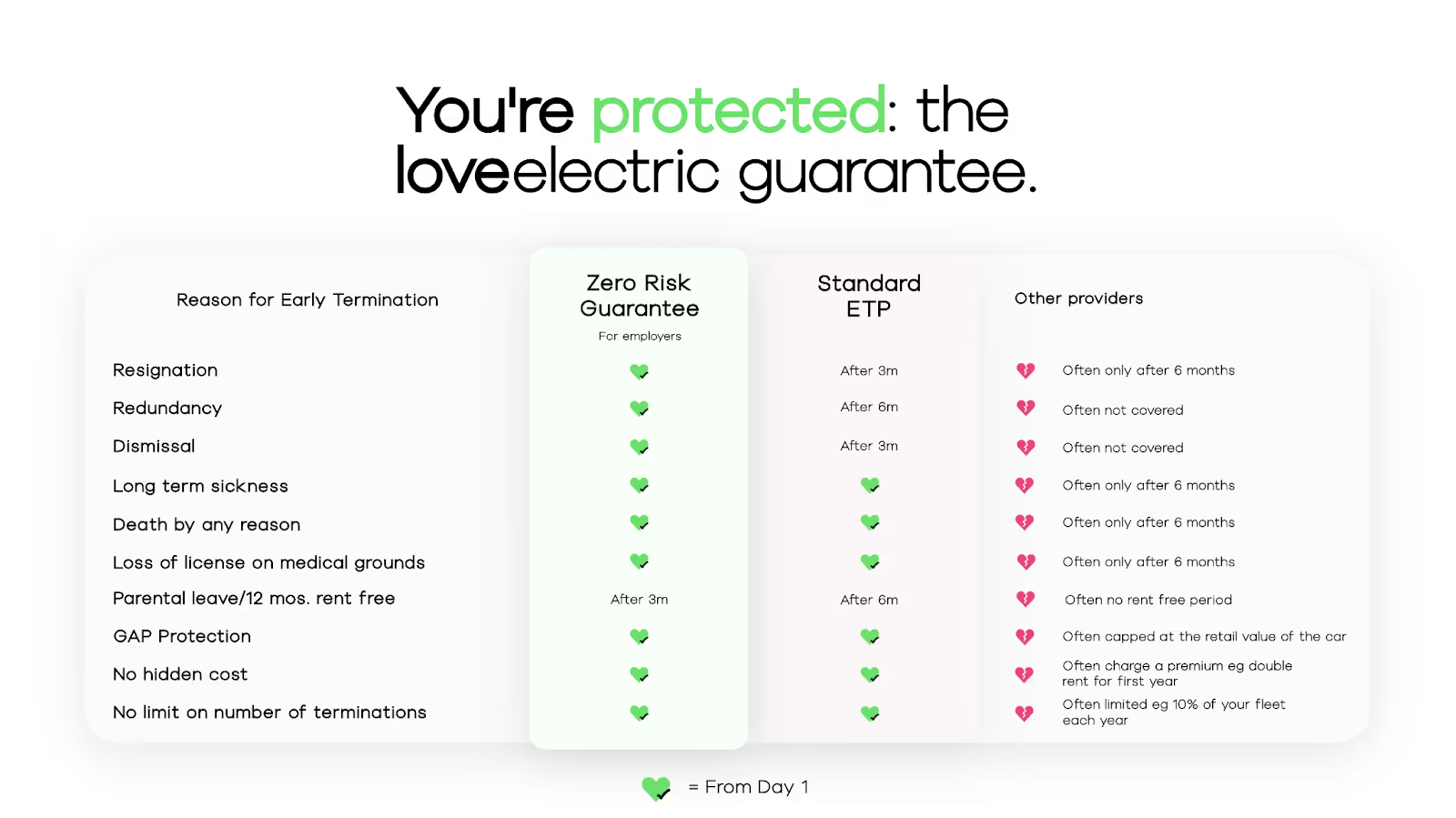Electric car company tax benefits: why EVs make financial sense for UK businesses
.avif)
For years, going electric was seen as the right thing to do. Now it’s also a smart financial move.
The UK government wants businesses to lead the charge toward Net Zero, and it’s rewarding those that do with generous, long-term tax incentives. From corporation tax relief to lower National Insurance and VAT savings, these electric car company tax benefits are reshaping how employers think about company cars.
In this guide, we’ll break down every incentive, show what the numbers look like in practice, and explain why salary sacrifice is the easiest way for companies to make the switch, with loveelectric managing it all.
Why the government is rewarding companies who go electric
The UK government isn’t just encouraging drivers to go electric, it’s actively rewarding the businesses that make it happen.
As part of its Net Zero by 2035 target and plan to phase out new petrol and diesel vehicles, the government has built powerful tax incentives into the system. These incentives make it cheaper for companies to buy, lease, or offer electric vehicles (EVs) to employees.
From corporation tax relief to lower National Insurance contributions, every part of the EV ownership journey has been designed to make electric the smarter financial choice. Unlike one-off grants or temporary discounts, these incentives are written into HMRC’s long-term tax policy.
3 ways businesses can provide electric company cars to employees
There’s more than one way for a business to go electric and each option comes with its own set of tax advantages. The right choice depends on whether your company wants to own, lease, or provide cars as an employee benefit.
1. Company-owned cars
This is the traditional approach, and it's where the business buys the vehicle outright and lists it as a company asset.
It’s most common for director cars or fleet vehicles that the company intends to keep long term.
The business covers the cost of purchase, insurance, maintenance, and running costs, while employees or directors can use the car for business and (in some cases) personal journeys.
2. Business leases
Rather than purchasing outright, the business leases the car through a finance provider.
This offers predictable monthly payments and less commitment than ownership, which is ideal for businesses wanting flexibility or lower upfront costs.
The company pays a fixed monthly fee and retains responsibility for how the car is used, typically as a fleet vehicle or for director use. It’s also popular for employees who have to drive as part of the job. Think of an operations rep who has to visit facilities across the UK.
3. Salary sacrifice electric car schemes
Salary sacrifice electric vehicle schemes let employees lease an electric car through their employer.
So, instead of the business buying or leasing cars directly, employees choose and pay for their EV through a reduction in their gross salary.
This has quickly become one of the most popular ways for businesses to offer electric cars. It gives employees access to EVs at no direct cost to the employer, with minimal admin when managed through a provider like loveelectric.
Car company tax benefits at a glance
Below you can see the core electric car company tax benefits on offer and how those benefits play out in the three ways companies provide EVs to their employees:
The main electric car company tax benefits
The UK tax system rewards companies that choose electric at almost every step, from how you buy or lease the car to how it’s used by employees.
Here’s a breakdown of the main electric car company tax benefits and how they apply in practice.
Electric car corporation tax relief and capital allowances
When a business buys an electric car outright, the government allows it to claim 100% of the purchase cost as a capital allowance in the first year. That means you can deduct the full amount from your company’s taxable profits, directly reducing your corporation tax bill.
For example, if your company pays 25% corporation tax and buys a £40,000 electric car, you can deduct the entire £40,000 from your profits—saving £10,000 in tax that year.
This incentive, known as the First-Year Allowance (FYA), was introduced to encourage businesses to invest in low-emission vehicles. Petrol and diesel cars don’t qualify for this level of relief.
There’s also a 100% first-year allowance available for EV charge-point installations, valid until March 2026 (by government extension), which helps businesses build the infrastructure they need to go electric.
How to calculate your tax savings:
To estimate how much your business could save through capital allowances:
- Find the car’s list price (excluding VAT).
Example: £40,000. - Multiply by your corporation tax rate.
Example: £40,000 × 25% = £10,000 saved. - Apply the same logic for charge points or additional EV purchases.
Each qualifying asset can be deducted in full during the first year.
Who corporation tax relief and capital allowances applies to:
- Company-owned cars: Businesses can claim the full 100% first-year capital allowance on new electric vehicles they purchase outright.
- Business leases: Leased vehicles don’t qualify for capital allowances, but the monthly lease payments are treated as tax-deductible expenses, reducing profits in a similar way over time.
- Salary sacrifice schemes: Employers can’t claim capital allowances here because the vehicle isn’t owned or leased by the company.
Lower Class 1A National Insurance contributions
When a company provides a car to an employee, it has to pay Class 1A National Insurance contributions (NICs) based on the vehicle’s Benefit-in-Kind (BiK) value.
Because electric cars have a much lower BiK rate than petrol or diesel cars, the employer’s NIC bill is dramatically smaller.
For the 2025/26 tax year, the BiK rate for fully electric cars is just 3%, compared to 25–37% for traditional vehicles.
That means a company providing an electric car worth £40,000 pays NICs on only £1,200, rather than £10,000–£15,000 for a petrol car.
Do note that the BiK rate for electric vehicles is set to increase incrementally year on year until 2029 when it will reach 9%.
How to calculate your NIC savings
- Find the car’s BiK value.
- EV BiK = 3% of list price
- Petrol BiK = 25%+ of list price
- Multiply that by the Class 1A NI rate (13.8%).
Example for a £40,000 EV:
£40,000 × 3% × 13.8% = £165 per year
Compare that to a £40,000 petrol car at 25% BiK:
£40,000 × 25% × 13.8% = £1,380 per year
That’s an annual employer saving of £1,215 on just one car.
Who NIC savings applies to
- Company-owned cars: Employers pay NICs on the BiK value — which is minimal for EVs.
- Business leases: The same principle applies. NICs are based on the car’s low BiK rate, not the full lease cost.
- Salary sacrifice schemes: Employers save 13.8% NICs on every pound employees sacrifice from their gross salary, while employees save on their own Income Tax and NI. That’s what makes salary sacrifice one of the most cost-neutral employee benefits available.
VAT savings on electric company cars
VAT treatment for electric vehicles follows the same basic rules as for petrol or diesel cars but there are still valuable opportunities to reclaim part of the VAT, especially for leased cars or those used exclusively for business.
How VAT works depending on how you get the car
Company-owned cars
If your company buys an electric car outright, you can only reclaim VAT if the vehicle is used exclusively for business purposes, meaning no personal trips or commuting.
Because that’s rarely the case, most businesses can’t reclaim VAT on the car purchase itself.
However, VAT can be reclaimed on related costs such as:
- Servicing, repairs, and maintenance
- Electricity used to charge the vehicle at the workplace
- Installation and upkeep of workplace charge points
Note: If employees charge at home, that electricity is classed as personal use and isn’t eligible for VAT recovery.
Business leases
Leasing an EV gives businesses far more flexibility with VAT. HMRC allows you to reclaim:
- 50% of the VAT on the lease payments if the car is available for private use
- 100% of the VAT on any maintenance package included in the lease
This approach gives predictable monthly costs and steady VAT recovery over time. It’s a big reason many companies choose leasing over outright purchase.
Salary sacrifice EV schemes
In a salary sacrifice arrangement, the VAT management happens behind the scenes.
The lease provider reclaims VAT on the car and its maintenance, then builds those savings directly into the lease pricing. That means employers don’t pay or reclaim VAT themselves as the benefit is passed through automatically.
It’s one of the simplest and most admin-free ways for businesses to access the VAT advantages of electric vehicles.
How to calculate what you can reclaim
For leased cars: Take your monthly lease cost (excluding VAT). Add 20% VAT, then reclaim 50% of that VAT. Example: £500 lease + £100 VAT = £600 total. You can reclaim £50 VAT per month.
For maintenance: You can reclaim 100% of the VAT on maintenance packages or repairs tied to the lease.
For workplace charging and charge points: VAT can be reclaimed in full if the electricity or charge point is used only for business vehicles.
No fuel benefit charge on electric company cars
One of the quietest but most valuable tax perks of switching to electric is that there’s no fuel benefit charge.
For petrol and diesel cars, HMRC applies an extra tax whenever the company pays for an employee’s private fuel use. It’s known as the fuel benefit charge and it can add thousands of pounds in taxable benefit each year.
Electric vehicles are treated differently. Even if the business covers the cost of charging, whether at work or through workplace charge points, there’s no equivalent taxable benefit.
That means both the employer and the employee avoid a major additional tax liability simply by choosing electric over petrol or diesel.
How the fuel benefit charge works
For petrol and diesel cars, the charge is calculated using a government-set fuel benefit multiplier (£27,800 for 2024/25) multiplied by the car’s BiK percentage.
So, for a petrol car with a 25% BiK: £27,800 × 25% = £6,950 taxable benefit
If the employer pays for that fuel, both the employee and the company owe extra tax and National Insurance based on that figure.
But as you now know, for electric vehicles, that same calculation simply doesn’t apply and the fuel benefit charge is £0.
By providing an electric car instead of a petrol model, the company avoids nearly £1,000 in employer NICs and the employee avoids tax on a £6,950 benefit each year.
Who the fuel benefit charge applies to
- Company-owned cars: No taxable fuel benefit, even if the company pays for electricity.
- Business leases: Same treatment; electricity used for charging is not considered a fuel benefit.
- Salary sacrifice schemes: Employees charge their cars privately, so there’s no taxable fuel benefit at all.
Salary sacrifice — the most accessible way to unlock EV tax benefits
At its core, the EV salary sacrifice scheme gives employees access to a car at an affordable price while costing the company nothing.
But behind that simplicity is a financial mechanism that reshapes how tax and benefit costs flow through payroll, often producing net savings for the business and meaningful disposable income gains for staff.
EV salary sacrifice works so well because electric cars sit in a tax sweet spot. They combine three separate government incentives into one scheme:
- Low Benefit-in-Kind tax — set at just 3% for 2025/26, compared with 25–37% for petrol cars.
- Reduced employer NICs — 13.8% savings on every pound of salary exchanged.
- Exemption from OpRA limits — meaning the full tax advantage is protected and HMRC-backed.
It’s one of the few employee benefits where everyone saves, employees, employers, and the environment. You can learn more about the employee tax benefits of an EV salary sacrifice scheme here: Employee tax benefits for EV schemes: How salary sacrifice with loveelectric saves you thousands.
When you implement salary sacrifice for EVs:
- You reduce payroll tax outflows instantly through NIC savings.
- You introduce a high-value benefit at zero net cost.
- You enhance ESG and sustainability reporting by cutting fleet emissions.
Even better, because loveelectric handles setup, contracts, and payroll integration, the entire process is admin-light and risk-free. Your HR and finance teams don’t take on liability or complex management
Here’s how the numbers play out:
📚Further reading: How Does Salary Sacrifice for Cars Work: A Guide to the EV Scheme
What to consider when implementing salary sacrifice for employee and employer tax benefits
Understanding the tax benefits is one thing. Making them work smoothly inside your business is another.
Before launching a scheme, there are a few practical checks worth making to decide whether an EV salary sacrifice scheme is worth it.
First, salary sacrifice can’t reduce any employee’s pay below the National Minimum Wage.
That limits eligibility slightly, but loveelectric’s structure, including our Reloved® range, makes it possible for staff earning from around £27,000 to take part compliantly.
Second, consider what happens if someone leaves mid-lease. Early termination is usually where risk hides, but loveelectric’s Zero Risk Guarantee protects both sides, covering resignation, redundancy, illness, and parental leave.

Finally, make sure payroll is set up correctly. Deductions, NIC savings, and Benefit-in-Kind reporting all need to flow automatically through payroll.
With loveelectric, those calculations are built in, keeping everything HMRC-aligned without adding admin.
Handled well, salary sacrifice becomes one of the few benefits that genuinely pays back. In lower taxes, simpler operations, and a stronger employee offering.
Ready to take your company electric with salary sacrifice?
If you’re ready to turn tax incentives into real savings, loveelectric makes it simple.
- Check your company’s eligibility in minutes → Eligibility checker
- Speak to our team to learn how salary sacrifice can work for your business → Book a chat
Explore available cars and see what your employees could drive for less → View cars





